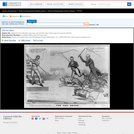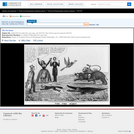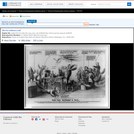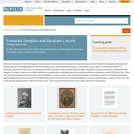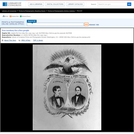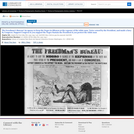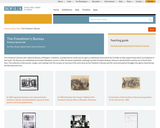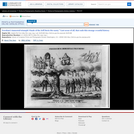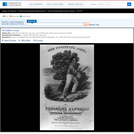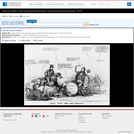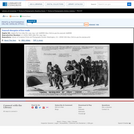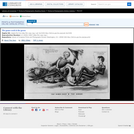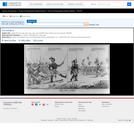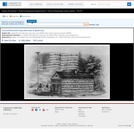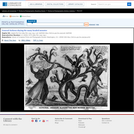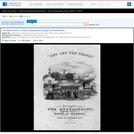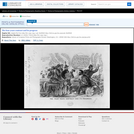
One of three anti-Lincoln satires published by Nichols in Boston at around the same time. (It was deposited for copyright on June 30, 1863, along with "Oppression!! Suppressing the Press" and "The Great American What Is It? Chased by Copper-heads" nos. 1863-6 and 1863-8). The present cartoon criticizes the Lincoln administration's mismanagement of the war, the "Four Years Contract" being the presidency. A barefoot Lincoln sits on a log labeled "Fredericksburg" (site of a major Union defeat under the leadership of Gen. Ambrose E. Burnside) and holds an ax between his legs, as he receives four members of the "Committee on War" at left, who also carry axes. He says to himself, "My axe is as dull as theirs so I hid it between my legs." The Committee on the Conduct of the War was formed in 1861 to investigate recent Union military failures. In front of them is a woodpile with logs inscribed with the names of Southern cities, such as "Richmond," "Mobile," and "Charleston." Ensconced in the pile is a tiny black man who cries out, "Massar.r.r." Beneath a nearby grindstone lurks a copperhead (nickname of the Peace Democrats, who opposed Lincoln's wartime policies). The members of the committee (from left to right) report: Man with top hat: "Mr. President. There is a nigger in the woodpile dont you here him holler. Old song." Second man: "Abe., We found Fremont [Union Officer John C. Fremont] all run out, but we have fixed him up as good as new and I invented the first lie about McClellan." In 1862 Gen. George B. McClellan was relieved from command of the Army of the Potomac (some said for political reasons) and later became the presidential candidate of the Peace Democrats. Bareheaded man: "Abe--I've been in Mac's Com-sary department and found the provisions good, as I stole a sheep that he left in Maryland and twas excellent." Man carrying a large book "Committee on War Full Report": Mr. Pres. We've got axes to grind, as they got dreadful dull in trying to cut up McClellan's character & by the way cant you do something for us now?" Lincoln addresses them: "Sirs; Your report is recieved with profound pleasure, and your shall be great; but ther's a blasted Copperhead under the grindstone so that if you grind here you'll get bit and that is sure death. 'Mac' is the only one that can handle 'em, so I dont see what I'm going to do. 'Mac' gave that Richmond log a good crack and if I hadn't stole his Wedge, he would have split it sure and if my heels want so long I'd go to Trenton and get him back. I am this moment getting a despatch from Fr so I must bid you all good day. 1st News Good, Good, Good. 2nd News Thunderation!" The term "Copperhead" referred to Peace Democrats and others who advocated a negotiated reconciliation with the South. A Union officer behind Lincoln cuts with his ax into the Fredericksburg log, on which lies another copperhead. He announces, "1st Despatch Copperhead cut off, his capture certain. 2nd Despatch He has escaped through the gap and threatened our positions." In the right background, "Stone-Man" a figure made of stones standing on a horse, comments, "Mr. Pres. I have been to the rear and owing to my great weight I have broken down a number of bridges." The figure no doubt represents Gen. John Stonemen, commander of Union cavalry during the recent defeat at Chancellorsville. At far left a two-headed man, "Wilke's Spirit by a Medium," observes, "Mac is a slow hoss but there's no use in trying to run him down." In November 1861 Union naval officer Charles Wilkes captured Southern diplomats James Murray Mason and John Slidell on the "Trent," a British merchant ship. Beside him is a sign "Lies told for cash." In the distance are a dog, a rooster, a horse, and a boxing match.|Entered . . . 1863 by E.W.T. Nichols . . . Mass.|The Library's impression of the work was deposited for copyright on June 30, 1863. |Title appears as it is written on the item.|Weitenkampf, p. 139.|Forms part of: American cartoon print filing series (Library of Congress)|Published in: American political prints, 1766-1876 / Bernard F. Reilly. Boston : G.K. Hall, 1991, entry 1863-7.
- Subject:
- History
- U.S. History
- Material Type:
- Diagram/Illustration
- Primary Source
- Provider:
- Library of Congress
- Provider Set:
- Library of Congress - Cartoons 1766-1876
- Date Added:
- 06/13/2013
